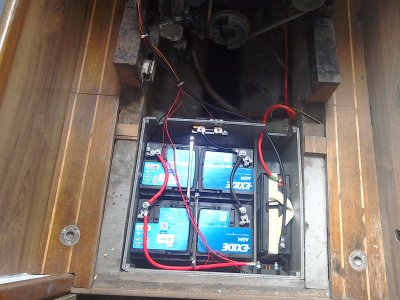dje67
Member
I have 5 of these batteries, arranged into a bank of 2 and a bank of 3, with a single (at the moment) hand-off to the battery isolator switch. All batteries are in a 1m2 area, so quite close to each other.
https://cdn.tayna.com/datasheets/LDC12-115-G31-DT.pdf
The batteries have dual connectors on + and - I.e. the conventional round lug and a 3/8” threaded post.
2 questions for those that know such things:-
1) are the threaded posts (rather than the conventional round lugs) better in terms of losses/volt-drops when bringing each battery in a bank together, and for the final hand-off of each bank, which of the connections is best?
2) to equalise load on each individual battery, what is the best, low-resistance ‘pattern’ for bringing the whole bank up to the isolator? Feed each bank directly to the isolator (I.e. 2 feeds, one from each bank), or bring the 2 banks together on one of the banks before sending a single hand-off to the isolator? Same obviously applies to the -ve side of the bank(s).
Finally, I’m looking at using 70mm2 cables for all this. Might be overkill? Highest loads are windlass (around 90A) and an EasySolar charger/inverter 1300W continuous, say 130A. I want to minimise volt-drop as the fridge (at the end of a longish chain of switches and cables through the switch panel) gets upset if battery volts drop below 12.4V, when other loads kick-in.
https://cdn.tayna.com/datasheets/LDC12-115-G31-DT.pdf
The batteries have dual connectors on + and - I.e. the conventional round lug and a 3/8” threaded post.
2 questions for those that know such things:-
1) are the threaded posts (rather than the conventional round lugs) better in terms of losses/volt-drops when bringing each battery in a bank together, and for the final hand-off of each bank, which of the connections is best?
2) to equalise load on each individual battery, what is the best, low-resistance ‘pattern’ for bringing the whole bank up to the isolator? Feed each bank directly to the isolator (I.e. 2 feeds, one from each bank), or bring the 2 banks together on one of the banks before sending a single hand-off to the isolator? Same obviously applies to the -ve side of the bank(s).
Finally, I’m looking at using 70mm2 cables for all this. Might be overkill? Highest loads are windlass (around 90A) and an EasySolar charger/inverter 1300W continuous, say 130A. I want to minimise volt-drop as the fridge (at the end of a longish chain of switches and cables through the switch panel) gets upset if battery volts drop below 12.4V, when other loads kick-in.

